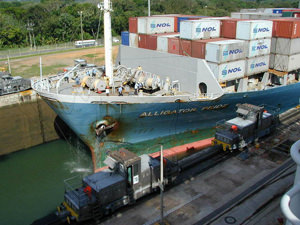Having celebrated the centenary of its opening last year, DAVID ADAMS looks at the history of the Panama Canal…

|
A ship makes it way through the canal. PICTURE: www.freeimages.com |
The Panama Canal last year marked the 100th anniversary of its official opening so we thought it was time to take a look at how a project, frequently hailed as one of the world’s greatest engineering feats, came into existence.
There had for centuries been talk of digging a canal across the narrow isthmus linking north and south America, providing a means for ships to pass from the Atlantic to the Pacific Ocean (and vice versa) without having to take the rather lengthy and dangerous trip around Cape Horn at the southern tip of South America.
But it wasn’t until 1881 that France began work on such a structure. But ongoing engineering problems and a high death rate thanks to disease and wildlife including snakes, spiders and insects led to them to eventually abandon the project.
In stepped the United States. It took over the project in early 1904 (President Theodore Roosevelt himself visited in late 1906) and just over 10 years (and $US352 million) later, thanks in large part to the heavy machinery the US used and the efforts they made to counter the two major killers of malaria and yellow fever, they were able to announce the completion of the 80 kilometre waterway on 15th August, 1914. The first vessel to officially complete a journey through canal was the steamship SS Ancon that same day.
As many as 50,000 workers – largely unskilled labour recruited from Caribbean Islands – had been employed in the US project. The death toll was somewhat staggering – more than 20,000 died during the French project and a further 5,600 due to disease and accidents in the US project.
The canal attracted considerable interest from sightseers during construction with an estimated 68,000 European and Americans visiting between 1910 and 1913 (and the tourists still come in great numbers today).
The US retained control of the canal until 1977 when a treaty was signed which would see the canal pass into the control of the Panamanian Government. After a period of joint control, this finally took place in 1999 and the canal is now controlled by the Panamanian Government Agency, the Panama Canal Authority.
The canal, which operates 24/7 all year round, initially heads south from the Atlantic Ocean and then heads eastward. It features a series of locks which raise the ships from sea level at either end to the level of Gatun Lake, 26 metres above sea level.
About 1000 ships passed through the canal in 1914 – this figure has now grown to between 13,000 and 14,000 ships annually with $US1.8 billion in tolls collected. It takes ships an average of eight to ten hours to pass through the canal. The millionth ship passed through the canal in 2010.
A $US5 billion project to expand the canal is now underway which will allow larger so-called “post-Panamex” ships to traverse it.
~ www.sil.si.edu/Exhibitions/Make-the-Dirt-Fly/
~ www.history.com/news/7-fascinating-facts-about-the-panama-canal
FOR MORE OF ORIGINS CLICK HERE…
If you have something you’d like to know the origins of, simply send an email to [email protected].





